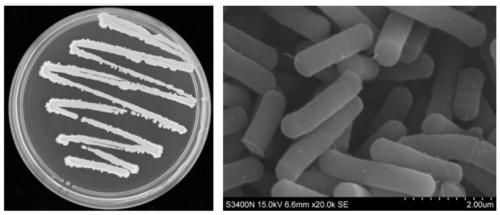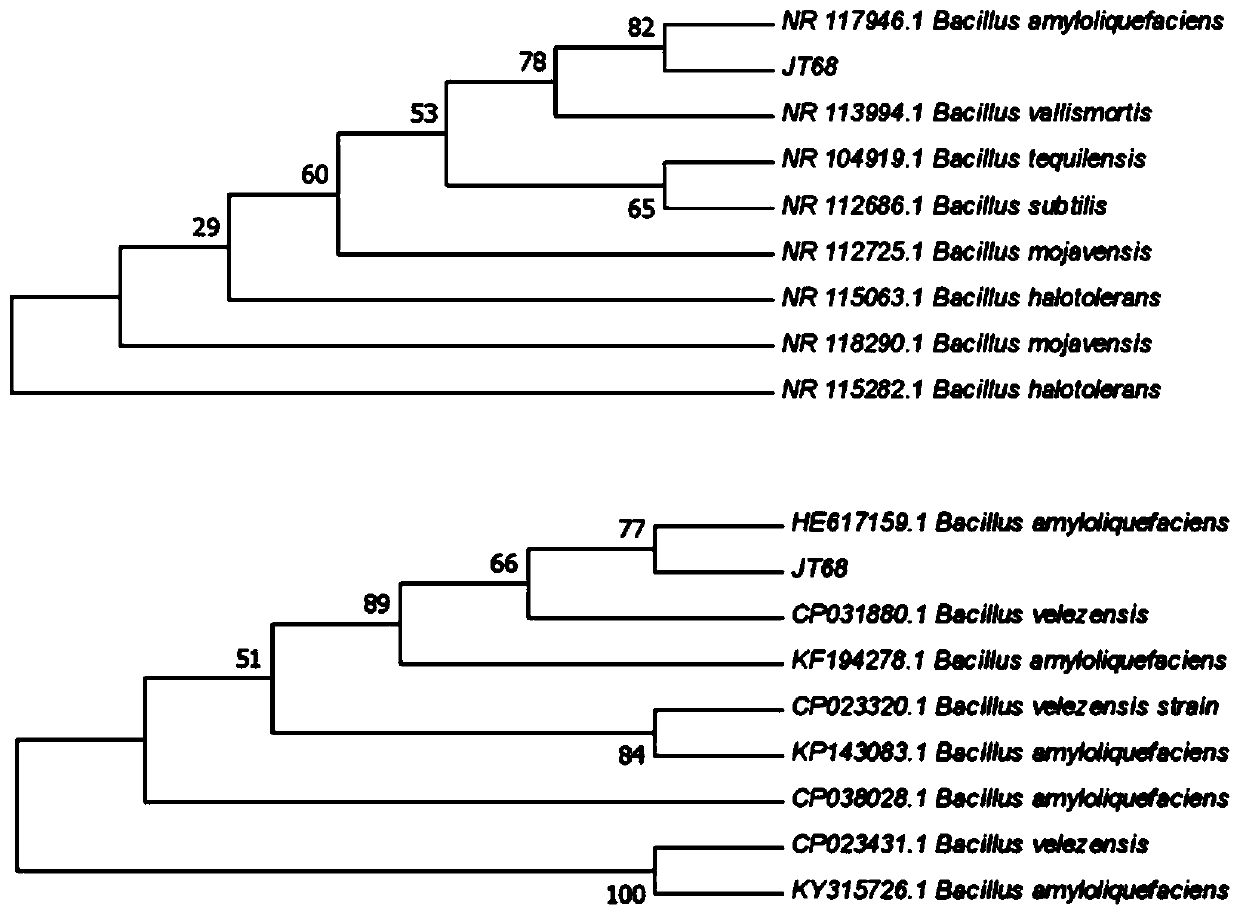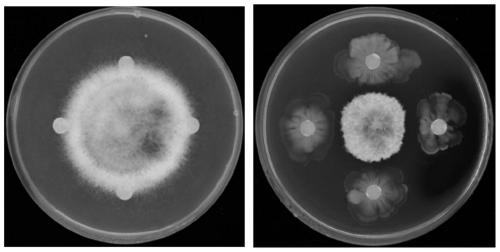Bacillus amyloliquefaciens JT68 and application thereof in prevention and control of tea anthracnose
A technology for desolvating amyloliquefaciens and JT68, which is applied to Bacillus amyloliquefaciens JT68 and its application in preventing and controlling tea anthracnose, can solve problems such as differences in effects, and achieve the effects of reducing spore germination, reducing pesticide residues, and inhibiting mycelial growth.
- Summary
- Abstract
- Description
- Claims
- Application Information
AI Technical Summary
Problems solved by technology
Method used
Image
Examples
Embodiment 1
[0033] Example 1 Isolation and Screening of Bacillus amyloliquefaciens JT68
[0034] 1. Sample collection:
[0035] The soil samples were collected from the paddy field soil of the school farm of South China Agricultural University (the location is Yuejin North Farm of South China Agricultural University, Tianhe District, Guangzhou City, Guangdong Province). Fill the paddy field soil with 50mL sterilized centrifuge tube and take it back to the laboratory for isolation.
[0036] 2. Separation of biocontrol bacteria:
[0037] Mix each soil sample evenly, divide into packages and arrange numbers, take 1 / 3 of the soil samples in 10mL centrifuge tubes, add sterilized water to 10mL, vibrate vigorously to make a suspension, and record the concentration of the obtained suspension as 1 ×10 -1 . Then in 80 ° C water bath for 15 min. Draw 1mL 1×10 -1 The soil sample suspension into a new centrifuge tube filled with 9mL sterile water, diluted to 1 × 10 -2 , 1×10 -3 series concentr...
Embodiment 2
[0045] The identification of embodiment 2 bacillus amyloliquefaciens JT68
[0046] 1. Morphological identification
[0047] The bacterial strain JT68 obtained by screening in Example 1 is cultivated on LB medium, and the morphological characteristics are observed: a single colony is a regular circle, white, milky, and the colony is relatively large with a smooth surface. Electron microscopy showed that the bacteria were rod-shaped, twins, with a diameter range of 2.0*5.8um (such as figure 1 ).
[0048] Physiological and biochemical identification results found that the strain JT68 is a Gram-positive bacterium, which can utilize sucrose, fructose, mannitol and maltose. The physiological and biochemical tests such as contact enzyme reaction, motility measurement, starch hydrolysis, V-P test, nitrate reduction, and gelatin liquefaction showed positive results. Positive, unable to utilize glucose and lactose, aerobic, oxidase reaction, methyl red test, hydrogen sulfide test, etc...
Embodiment 3
[0055] The preparation of embodiment 3 bacillus amyloliquefaciens JT68 fermented liquid
[0056] This example provides a scheme selection for preparing the fermentation broth of Bacillus amyloliquefaciens JT68.
[0057] First, the preserved strains were activated from a -80°C freezer. The activated colonies were picked with an inoculation loop and cultured at 30°C in LB liquid medium (yeast extract 5g, tryptone 10g, NaCl 5g, water 1000mL, pH 7.2, sterilized at 121°C for 15min), which was the seed liquid.
[0058] Then, take 1 mL of seed solution and add it to 100 mL of LB liquid medium, and culture at 30° C. at 180 r / m for 24 hours to obtain a fermentation liquid.
PUM
 Login to View More
Login to View More Abstract
Description
Claims
Application Information
 Login to View More
Login to View More - R&D
- Intellectual Property
- Life Sciences
- Materials
- Tech Scout
- Unparalleled Data Quality
- Higher Quality Content
- 60% Fewer Hallucinations
Browse by: Latest US Patents, China's latest patents, Technical Efficacy Thesaurus, Application Domain, Technology Topic, Popular Technical Reports.
© 2025 PatSnap. All rights reserved.Legal|Privacy policy|Modern Slavery Act Transparency Statement|Sitemap|About US| Contact US: help@patsnap.com



